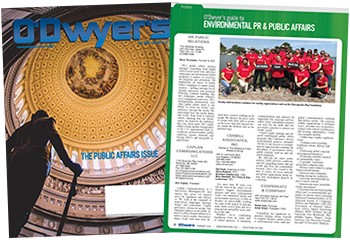 Eliza Roemisch |
Citizens across the globe last year witnessed several of the worst natural disasters on record with the destructive fire season in California, ravaging hurricanes impacting the Caribbean and continental U.S., and deadly earthquakes in Mexico and Iran.
These moments of crisis lead to unique challenges in communication for national and local brands alike; how do you as a public relations professional ensure that all messaging is sensitive and timely in disaster situations? It’s vital to be prepared to ensure appropriate efforts are made. Companies need to avoid being demonized for capitalizing on tragedy and instead become a source of assurance and reliability.
Plan ahead
While you can’t place natural disasters on your calendar, it’s important to have a plan in place well beforehand on how to effectively manage the crisis. This is especially true for events that occur annually, such as hurricane season in the late summer and early fall.
|
|
If you represent a client that produces a product used in disaster situations — i.e. batteries, blankets, dry goods, etc. — creating a separate budget for donations to affected areas allows for a timely response without unnecessary red tape. Proactively developing disaster messaging that’s strong and consistent, and that all parties agree on, goes a long way in ensuring your client is represented in a positive light throughout the crisis.
You should also be prepared to postpone sponsored posts and articles as messaging that’s normally innocuous can be easily viewed as insensitive during a crisis. Review any scheduled social media posts, influencer promotions or sponsored articles for messaging that can appear insensitive during a disaster. Should your target demographic be affected by the disaster, pause all branded and promotional messaging until an appropriate time has passed.
If your business will likely be affected by disasters, be prepared with messaging to communicate with your audience via social media and key news outlets on the status of your business and how your audience may be impacted.
Be adaptable
In a crisis, it’s paramount to have a strategy in place, and be adaptable with resources, relief efforts and messaging. For example, within 24 hours of learning about a leading non-profit’s project to raise funds following Hurricanes Harvey, Irma and Maria, call center ListenTrust coordinated two major telethon events, set up two on-site phone banks and even sent an employee to each location to oversee the operations. Timely reactions such as these require adaptability and clear communication. The company took more than 80,000 donation calls in a three week period, depicting the call center as a company that cares to give back to both the local community and communities around the world.
In a crisis, having clear and approved messaging in addition to a strategy is key to an effective public relations plan. Identify the spokesperson who will be in communication with media and the public. Media moves fast during a crisis, and being able to provide up-to-date information and professional reaction will help the company be portrayed as a reliable source to media and an expert in the field to the public.
When pitching to media, tell stories as opposed to platitudes. As many companies, celebrities and non-profit organizations will step up in a time of need, consider what will make your company stand out. Effective messaging will incorporate human interest and tell the stories of real people, not be canned messages offering support and cliché well wishing. By providing media with compelling human-interest stories told by real people, your company will be able to successfully tell the story of the support you provided to those affected at ground zero.
Be sensitive, not punny
Making jokes or puns in any messaging related to natural disasters is a sure-fire way to receive backlash and negative publicity. For example, in 2012 in the wake of Hurricane Sandy, Urban Outfitters received negative backlash after advertising a sale by saying, “This storm blows (but free shipping doesn’t).” The company’s adverse promotion landed it in Business Insider’s article “The 9 Biggest Brand Fails Exploiting Hurricane Sandy.” As many companies have learned the hard way, humor has its place in marketing, but not during a time of disaster.
Beyond keeping a serious tone, make sure your brand’s messaging puts brand building on the back burner. A company should see a natural disaster as an opportunity to develop stronger relationships with customers rather than increasing profits and placements. Focus messaging on employees and community first, and business second. Let the company’s actions lead the story and set the tone. Be sure to maintain a respectful voice and avoid positioning charitable efforts as a way to win placements for your client. Humanitarian relief should be placed in the light of kindness, not of business strategy.
As a communication specialist, it’s your job to provide wise counsel and manage client expectations. Advise the business on the importance of communicating with caution as talking about relief efforts too soon can result in negative feedback. All messaging needs to be well thought out and planned to avoid articles that are poorly timed or places the client in a bad light.
Run the marathon, not the sprint
It can be tempting to focus messaging around a natural disaster for a short period of time, but the positive community relations you can build surrounding calamities are best created with time. Consider how a business can benefit from both short-term relief efforts and long-term involvement. For example, it’s important immediately following disasters that public relations efforts focus on bringing back tourism to the affected areas. Not only is it good business, but it also helps rebuild the affected community and economy.
The key to ensuring that your messaging is sensitive and timely in disaster situations is to view everything through two frames: the immediate emotions and states of your client’s community and the longer view of building goodwill and trust. Remember that sacrificing placements and sales in the short term can be the best option to building a strong community that trusts your brand. During disasters, people have very strong memories and they’ll remember the brands that were there during the challenging times, be it positive memories of the supportive brands or brands that took advantage of them and the disaster.
***
Eliza Roemisch is Marketing Maven’s Creative Specialist, responsible for asset development and brand messaging via multiple mediums, including social media. She can be reached at [email protected].



 There’s a fine line between newsjacking and taking advantage, aka ambulance chasing. Our job as PR professionals is to tread it carefully.
There’s a fine line between newsjacking and taking advantage, aka ambulance chasing. Our job as PR professionals is to tread it carefully. PR firms need to be mindful of ways their work product may be protected by the attorney-client privilege whenever working with a client’s internal legal team or its external legal counsel.
PR firms need to be mindful of ways their work product may be protected by the attorney-client privilege whenever working with a client’s internal legal team or its external legal counsel. Manuel Rocha, former US ambassador and intenational business advisor to LLYC, plans to plead guilty to charges that he was a secret agent for Cuba.
Manuel Rocha, former US ambassador and intenational business advisor to LLYC, plans to plead guilty to charges that he was a secret agent for Cuba. CEO mentoring is an often-overlooked aspect of why CEOs are able to make good decisions, and sometimes make bad ones—all of which intersects with the role and duties of a board.
CEO mentoring is an often-overlooked aspect of why CEOs are able to make good decisions, and sometimes make bad ones—all of which intersects with the role and duties of a board.  How organizations can anticipate, prepare and respond to crises in an increasingly complex world where a convergent landscape of global challenges, threats and risks seem to arrive at an unrelenting pace.
How organizations can anticipate, prepare and respond to crises in an increasingly complex world where a convergent landscape of global challenges, threats and risks seem to arrive at an unrelenting pace.


 Have a comment? Send it to
Have a comment? Send it to 
No comments have been submitted for this story yet.